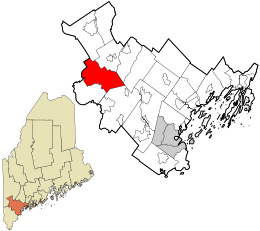Sebago, Maine
| Sebago, Maine | |
|---|---|
| Town | |

Sebago Community Church
|
|
 Location in Cumberland County and the state of Maine. |
|
| Coordinates: 43°53′14″N 70°40′39″W / 43.88722°N 70.67750°WCoordinates: 43°53′14″N 70°40′39″W / 43.88722°N 70.67750°W | |
| Country | United States |
| State | Maine |
| County | Cumberland |
| Incorporated | 1826 |
| Area | |
| • Total | 48.93 sq mi (126.73 km2) |
| • Land | 32.76 sq mi (84.85 km2) |
| • Water | 16.17 sq mi (41.88 km2) |
| Elevation | 410 ft (125 m) |
| Population (2010) | |
| • Total | 1,719 |
| • Estimate (2012) | 1,738 |
| • Density | 52.5/sq mi (20.3/km2) |
| Time zone | Eastern (EST) (UTC-5) |
| • Summer (DST) | EDT (UTC-4) |
| ZIP code | 04029 |
| Area code(s) | 207 |
| FIPS code | 23-66775 |
| GNIS feature ID | 0582717 |
| Website | www |
Sebago is a town in Cumberland County, Maine, United States. The population was 1,719 at the 2010 census. It is part of the Portland–South Portland–Biddeford, Maine metropolitan statistical area.
Originally called Flintstown, it was granted in 1774 by the Massachusetts General Court to survivors of Captain John Flint's company of soldiers from Concord, Massachusetts. It replaced a grant of 1735 that awarded them Township No. 3 (now Walpole, New Hampshire), but which was ruled invalid when the border between Massachusetts and New Hampshire was redrawn to satisfy prior claims by the descendants of John Mason. On June 23, 1802, Flintstown was incorporated as Baldwin. Then on February 10, 1826, Sebago was set off from Baldwin and incorporated as a separate town. It took the name of Sebago Lake. Land was annexed from Denmark in 1830, and taken in 1834 to help form Naples.
Lumberjacks and woodsmen were the first European inhabitants of the area, but they left as soon as the first growth of pine was cut. It 1790, Joseph Lakin from Groton, Massachusetts, built a cabin, then returned with his family and possessions. The surface of the town is very uneven and generally rocky, so it was hard work to clear a farm for cultivation. But the soil was good and yielded abundant crops. Mills were built at water power sites, and products included long and short lumber, shooks, and boots and shoes. In 1832, the Cumberland and Oxford Canal opened, increasing trade between Sebago Lake and Portland. In the early 1870s, the Portland and Ogdensburg Railroad carried tourists and freight to Sebago Lake Station in Standish, where steamboats took them to various landings around the lake. Inns, hotels and summer camps opened, and the town became a recreation area, which it remains today.
...
Wikipedia
